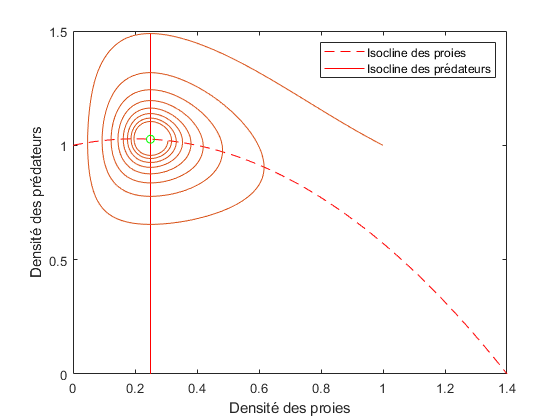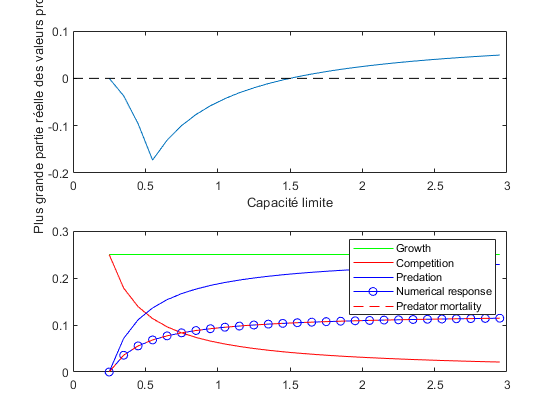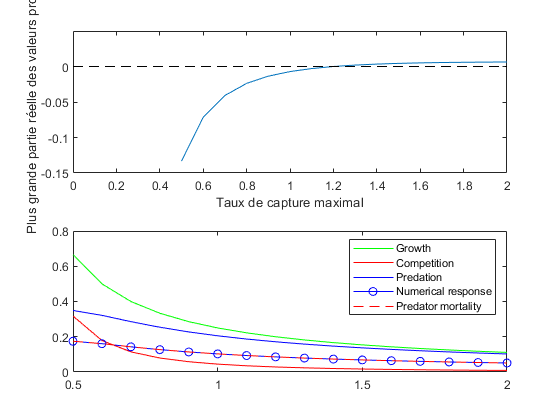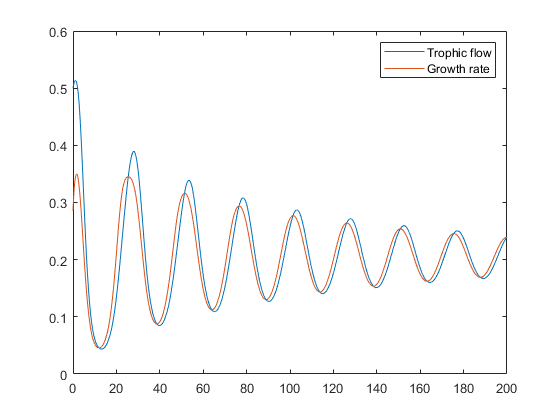clear all; clc;
global r K a b e m
r=1;K=1.53;a=1;b=1;e=0.5;m=0.1;
K=1.4;K00=K;
tmax=200;dt=0.1;
x0=1;y0=1;
nbx=100;
CI=[x0,y0];duree=0:dt:tmax;
xe=m/(e*a-m*b);
ye=isoclineprey(xe);
[t u]=ode45(@RMA,duree,CI);
x=u(:,1);y=u(:,2);
figure(1)
plotyy(t,x,t,y)
xlabel('Temps');ylabel('Densité des populations');
legend('Proie','Prédateur')
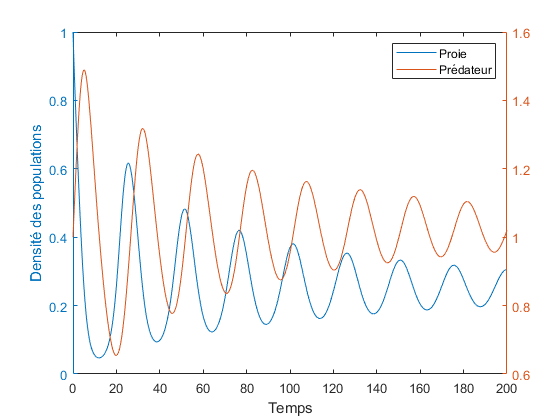
dx=K/nbx;xx=0:dx:K;
yy=isoclineprey(xx);
figure(2)
plot(xx,yy,'r--')
xlabel('Densité des proies');ylabel('Densité des prédateurs');
hold on
line([xe xe],[0 max(y)],'Color',[1,0,0])
plot(x,y,xe,ye,'go')
legend('Isocline des proies','Isocline des prédateurs')
hold off
Kmin=0.1;Kmax=3;dK=0.1;
Kmin=xe;Ue=[];
Lambda=[];YE=[];YEnum=[];uenum=[xe ye];
J11=[];J12=[];J21=[];J22=[];Ktamp=K;
for K=Kmin:dK:Kmax
ye=isoclineprey(xe);
ue=[xe ye];YE=[YE;ye];
Ue=[Ue;ue];
uenum=fsolve(@RMA2,uenum);YEnum=[YEnum;uenum];
J=JacobMat(ue);
J11=[J11 J(1,1)];J12=[J12 J(1,2)];J21=[J21 J(2,1)];J22=[J22 J(2,2)];
Lambda=[Lambda;max(real(eig(J)))];
end
figure(3)
subplot(2,1,1)
KK=Kmin:dK:Kmax;
plot(KK,Lambda,[0 Kmax],[0 0],'k--')
xlabel('Capacité limite');ylabel('Plus grande partie réelle des valeurs propres')
subplot(2,1,2)
Xe=Ue(:,1);Ye=Ue(:,2);
GROWTHeq=r*Xe;COMPETeq=Xe.^2./KK';
PREDATIONeq=a*Xe./(1+b*Xe).*Ye;NUMERICALRESPeq=e*a*Xe./(1+b*Xe).*Ye;
MORTALITYeq=m*Ye;
plot(KK',GROWTHeq,'g',KK',COMPETeq,'r',KK',PREDATIONeq,'b',KK',NUMERICALRESPeq,'-ob',KK',MORTALITYeq,'--r')
legend('Growth','Competition','Predation','Numerical response','Predator mortality')
K=Ktamp;
amin=0.5;da=0.1;amax=2;
Ue=[];
Lambda=[];YE=[];
J11=[];J12=[];J21=[];J22=[];atamp=a;
for a=amin:da:amax
xe=m/(e*a-m*b);
ye=isoclineprey(xe);
ue=[xe ye];YE=[YE;ye];
Ue=[Ue;ue];
J=JacobMat(ue);
J11=[J11 J(1,1)];J12=[J12 J(1,2)];J21=[J21 J(2,1)];J22=[J22 J(2,2)];
Lambda=[Lambda;max(real(eig(J)))];
end
figure(4)
subplot(2,1,1)
aa=amin:da:amax;
plot(aa,Lambda,[0 amax],[0 0],'k--')
xlabel('Taux de capture maximal');ylabel('Plus grande partie réelle des valeurs propres')
ylim([-0.15 0.05]);
subplot(2,1,2)
Xe=Ue(:,1);Ye=Ue(:,2);
GROWTHeq=r*Xe;COMPETeq=Xe.^2./K;
PREDATIONeq=aa'.*Xe./(1+b*Xe).*Ye;NUMERICALRESPeq=e*aa'.*Xe./(1+b*Xe).*Ye;
MORTALITYeq=m*Ye;
plot(aa',GROWTHeq,'g',aa',COMPETeq,'r',aa',PREDATIONeq,'b',aa',NUMERICALRESPeq,'-ob',aa',MORTALITYeq,'--r')
legend('Growth','Competition','Predation','Numerical response','Predator mortality')
a=atamp;
figure(5)
GROWTH=r*x.*(1-x/K00);
PREDATION=a*x./(1+b*x).*y;
plot(t,PREDATION,t,GROWTH)
legend('Trophic flow','Growth rate')
Equation solved.
fsolve completed because the vector of function values is near zero
as measured by the value of the function tolerance, and
the problem appears regular as measured by the gradient.
Equation solved.
fsolve completed because the vector of function values is near zero
as measured by the value of the function tolerance, and
the problem appears regular as measured by the gradient.
Equation solved.
fsolve completed because the vector of function values is near zero
as measured by the value of the function tolerance, and
the problem appears regular as measured by the gradient.
Equation solved.
fsolve completed because the vector of function values is near zero
as measured by the value of the function tolerance, and
the problem appears regular as measured by the gradient.
Equation solved.
fsolve completed because the vector of function values is near zero
as measured by the value of the function tolerance, and
the problem appears regular as measured by the gradient.
Equation solved.
fsolve completed because the vector of function values is near zero
as measured by the value of the function tolerance, and
the problem appears regular as measured by the gradient.
Equation solved.
fsolve completed because the vector of function values is near zero
as measured by the value of the function tolerance, and
the problem appears regular as measured by the gradient.
Equation solved.
fsolve completed because the vector of function values is near zero
as measured by the value of the function tolerance, and
the problem appears regular as measured by the gradient.
Equation solved.
fsolve completed because the vector of function values is near zero
as measured by the value of the function tolerance, and
the problem appears regular as measured by the gradient.
Equation solved.
fsolve completed because the vector of function values is near zero
as measured by the value of the function tolerance, and
the problem appears regular as measured by the gradient.
Equation solved.
fsolve completed because the vector of function values is near zero
as measured by the value of the function tolerance, and
the problem appears regular as measured by the gradient.
Equation solved.
fsolve completed because the vector of function values is near zero
as measured by the value of the function tolerance, and
the problem appears regular as measured by the gradient.
Equation solved.
fsolve completed because the vector of function values is near zero
as measured by the value of the function tolerance, and
the problem appears regular as measured by the gradient.
Equation solved.
fsolve completed because the vector of function values is near zero
as measured by the value of the function tolerance, and
the problem appears regular as measured by the gradient.
Equation solved.
fsolve completed because the vector of function values is near zero
as measured by the value of the function tolerance, and
the problem appears regular as measured by the gradient.
Equation solved.
fsolve completed because the vector of function values is near zero
as measured by the value of the function tolerance, and
the problem appears regular as measured by the gradient.
Equation solved.
fsolve completed because the vector of function values is near zero
as measured by the value of the function tolerance, and
the problem appears regular as measured by the gradient.
Equation solved.
fsolve completed because the vector of function values is near zero
as measured by the value of the function tolerance, and
the problem appears regular as measured by the gradient.
Equation solved.
fsolve completed because the vector of function values is near zero
as measured by the value of the function tolerance, and
the problem appears regular as measured by the gradient.
Equation solved.
fsolve completed because the vector of function values is near zero
as measured by the value of the function tolerance, and
the problem appears regular as measured by the gradient.
Equation solved.
fsolve completed because the vector of function values is near zero
as measured by the value of the function tolerance, and
the problem appears regular as measured by the gradient.
Equation solved.
fsolve completed because the vector of function values is near zero
as measured by the value of the function tolerance, and
the problem appears regular as measured by the gradient.
Equation solved.
fsolve completed because the vector of function values is near zero
as measured by the value of the function tolerance, and
the problem appears regular as measured by the gradient.
Equation solved.
fsolve completed because the vector of function values is near zero
as measured by the value of the function tolerance, and
the problem appears regular as measured by the gradient.
Equation solved.
fsolve completed because the vector of function values is near zero
as measured by the value of the function tolerance, and
the problem appears regular as measured by the gradient.
Equation solved.
fsolve completed because the vector of function values is near zero
as measured by the value of the function tolerance, and
the problem appears regular as measured by the gradient.
Equation solved.
fsolve completed because the vector of function values is near zero
as measured by the value of the function tolerance, and
the problem appears regular as measured by the gradient.
Equation solved.
fsolve completed because the vector of function values is near zero
as measured by the value of the function tolerance, and
the problem appears regular as measured by the gradient.
